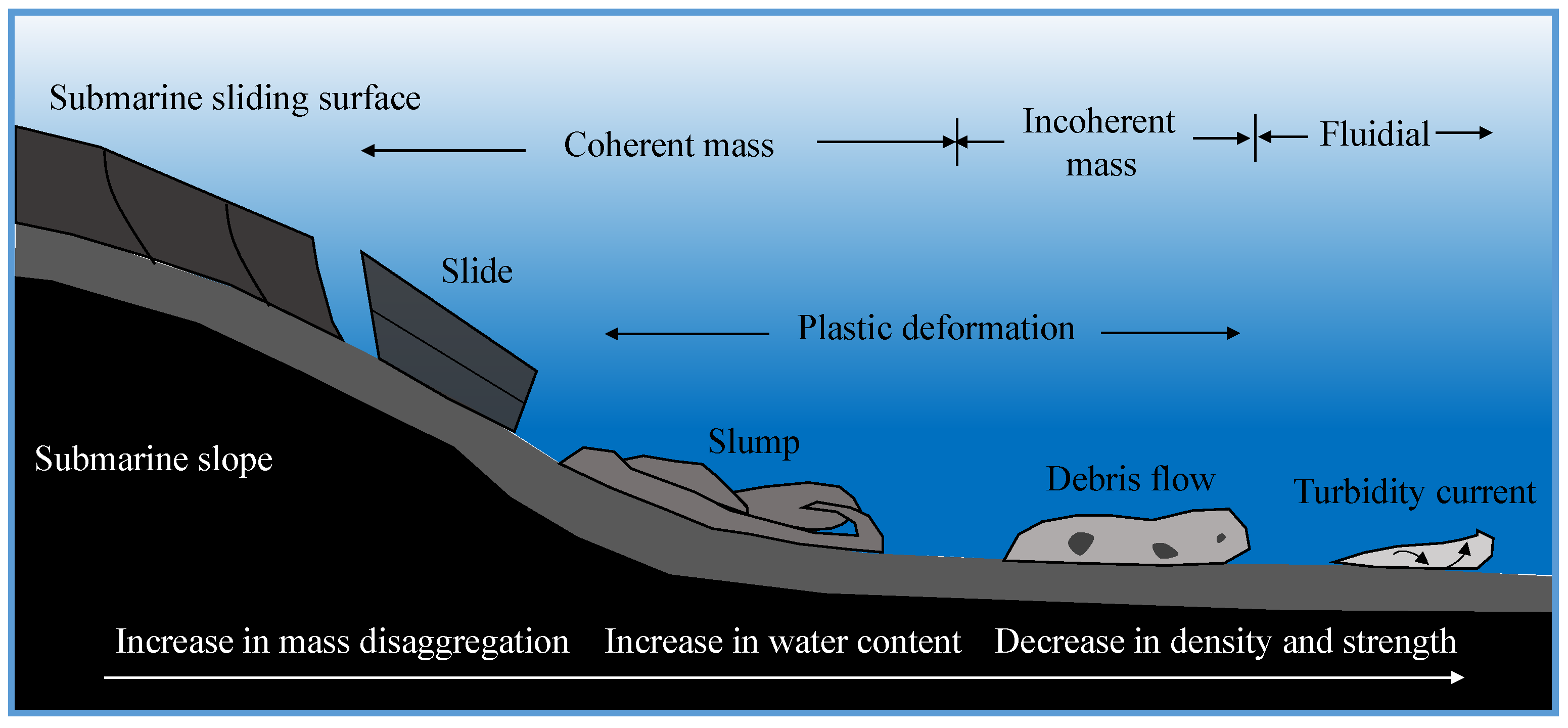Recent Technological and Methodological Advances for the Investigation of Submarine Landslides
Abstract
1. Introduction
2. Characteristics of Submarine Landslides
2.1. General Characteristics
2.2. Submarine Landslide Classification
3. Recent Advances in Submarine Landslide In-Situ Investigations
4. Recent Advances in Physical Simulation Methods of Submarine Landslides
5. Recent Advances in Numerical Simulation Methods of Submarine Landslides
6. Discussions on Future Research Directions
7. Conclusions
Author Contributions
Funding
Institutional Review Board Statement
Informed Consent Statement
Data Availability Statement
Acknowledgments
Conflicts of Interest
References
- Hampton, M.A.; Lee, H.J.; Locat, J. Submarine landslides. Rev. Geophys. 1996, 34, 33–59. [Google Scholar] [CrossRef]
- Masson, D.; Harbitz, C.; Wynn, R.; Pedersen, G.; Løvholt, F. Submarine landslides: Processes, triggers and hazard prediction. Philos. Trans. R. Soc. A 2006, 364, 2009–2039. [Google Scholar] [CrossRef] [PubMed]
- Vanneste, M.; Sultan, N.; Garziglia, S.; Forsberg, C.F.; L’Heureux, J.S. Seafloor instabilities and sediment deformation processes: The need for integrated, multi-disciplinary investigations. Mar. Geol. 2014, 352, 183–214. [Google Scholar] [CrossRef]
- Hance, J.J. Submarine Slope Stability. Master’s Thesis, The University of Texas at Austin, Austin, TX, USA, 2003. [Google Scholar]
- Hsu, S.K.; Kuo, J.; Chung-Liang, L.; Ching-Hui, T.; Doo, W.B.; Ku, C.Y.; Sibuet, J.C. Turbidity currents, submarine landslides and the 2006 Pingtung earthquake off SW Taiwan. TAO Terr. Atmos. Ocean. Sci. 2008, 19, 7. [Google Scholar] [CrossRef]
- Brune, S.; Ladage, S.; Babeyko, A.Y.; Müller, C.; Kopp, H.; Sobolev, S.V. Submarine landslides at the eastern Sunda margin: Observations and tsunami impact assessment. Nat. Hazards 2010, 54, 547–562. [Google Scholar] [CrossRef]
- Locat, J.; Lee, H. Submarine landslides: Advances and challenges. Can. Geotech. J. 2002, 39, 193–212. [Google Scholar] [CrossRef]
- Harbitz, C.B.; Løvholt, F.; Pedersen, G.; Masson, D.G. Mechanisms of tsunami generation by submarine landslides: A short review. Norw. J. Geol. 2006, 86, 255–264. [Google Scholar]
- De Mol, B.; Huvenne, V.; Canals, M. Cold-water coral banks and submarine landslides: A review. Int. J. Earth Sci. 2009, 98, 885–899. [Google Scholar] [CrossRef]
- Zhu, C.Q.; Jia, Y.G.; Liu, X.L.; Zhang, H.; Wen, Z.M.; Huang, M.; Shan, H.X. Classification and genetic mechanism of submarine landslide: A review. Mar. Geol. Quat. Geol. 2015, 35, 153–163. (In Chinese) [Google Scholar]
- Yavari-Ramshe, S.; Ataie-Ashtiani, B. Numerical modeling of subaerial and submarine landslide-generated tsunami waves—Recent advances and future challenges. Landslides 2016, 13, 1325–1368. [Google Scholar] [CrossRef]
- Jia, Y.G.; Wang, Z.H.; Liu, X.L.; Yang, Z.N.; Zhu, C.Q.; Wang, X.L.; Shan, H.X. The research progress of field investigation and in-situ observation methods for submarine landslide. Period. Ocean. Univ. China 2017, 10, 61–72. (In Chinese) [Google Scholar]
- Huhn, K.; Arroyo, M.; Cattaneo, A.; Clare, M.A.; Gràcia, E.; Harbitz, C.B.; Krastel, S.; Kopf, A.; Løvholt, F.; Rovere, M.; et al. Modern submarine landslide complexes: A short review. In Submarine Landslides: Subaqueous Mass Transport Deposits from Outcrops to Seismic Profiles, Geophysical Monograph, 1st ed.; Kei, O., Andrea, F., Gian, A.P., Eds.; John Wiley & Sons, Inc.: Hoboken, NJ, USA, 2019; pp. 181–200. [Google Scholar]
- Nian, T.K.; Shen, Y.Q.; Zheng, D.F.; Lei, D.Y. Research advances on the chain disasters of submarine landslides (in Chinese). J. Eng. Geol. 2021, 29, 1657–1675. [Google Scholar]
- Zhu, B.; Pei, H.; Yang, Q. Probability analysis of submarine landslides based on the Response Surface Method: A case study from the South China Sea. Appl. Ocean Res. 2018, 78, 167–179. [Google Scholar] [CrossRef]
- Bryn, P.; Berg, K.; Forsberg, C.F.; Solheim, A.; Kvalstad, T.J. Explaining the Storegga slide. Mar. Pet. Geol. 2005, 22, 11–19. [Google Scholar] [CrossRef]
- Laberg, J.; Vorren, T. The Trænadjupet Slide, offshore Norway—Morphology, evacuation and triggering mechanisms. Mar. Geol. 2000, 171, 95–114. [Google Scholar] [CrossRef]
- Vanneste, M.; Mienert, J.; Bünz, S.J.E. The Hinlopen Slide: A giant, submarine slope failure on the northern Svalbard margin, Arctic Ocean. Earth Planet. Sci. Lett. 2006, 245, 373–388. [Google Scholar] [CrossRef]
- Li, W.; Alves, T.M.; Urlaub, M.; Georgiopoulou, A.; Klaucke, I.; Wynn, R.B.; Gross, F.; Meyer, M.; Repschläger, J.; Berndt, C.; et al. Morphology, age and sediment dynamics of the upper headwall of the Sahara Slide Complex, Northwest Africa: Evidence for a large Late Holocene failure. Mar. Geol. 2017, 393, 109–123. [Google Scholar] [CrossRef]
- Weimer, P.; Slatt, R.M.; Bouroullec, R. Introduction to the Petroleum Geology of Deepwater Setting; AAPG/Datapages: Tulsa, OK, USA, 2007. [Google Scholar]
- Moscardelli, L.; Wood, L. New classification system for mass transport complexes in offshore Trinidad. Basin Res. 2008, 20, 73–98. [Google Scholar] [CrossRef]
- Guo, X.S.; Nian, T.K.; Gu, Z.D.; Li, D.Y.; Fan, N.; Zheng, D.F. Evaluation Methodology of Laminar-Turbulent Flow State for Fluidized Material with Special Reference to Submarine Landslide. J. Waterw. Port Coast. Ocean Eng. 2021, 147, 04020048. [Google Scholar] [CrossRef]
- Clare, M.A.; Vardy, M.E.; Cartigny, M.J.; Talling, P.J.; Himsworth, M.D.; Dix, J.K.; Harris, J.M.; Whitehouse, R.J.; Belal, M. Direct monitoring of active geohazards: Emerging geophysical tools for deep-water assessments. Near Surf. Geophys. 2017, 15, 427–444. [Google Scholar] [CrossRef]
- Hughes Clarke, J.E. First wide-angle view of channelized turbidity currents links migrating cyclic steps to flow characteristics. Nat. Commun. 2016, 7, 11896. [Google Scholar] [CrossRef] [PubMed]
- Kelner, M.; Migeon, S.; Tric, E.; Couboulex, F.; Dano, A.; Lebourg, T.; Taboada, A. Frequency and triggering of small-scale submarine landslides on decadal timescales: Analysis of 4D bathymetric data from the continental slope offshore Nice (France). Mar. Geol. 2016, 379, 281–297. [Google Scholar] [CrossRef]
- Mountjoy, J.J.; Howarth, J.D.; Orpin, A.R.; Barnes, P.M.; Bowden, D.A.; Rowden, A.A.; Schimel, A.C.; Holden, C.; Horgan, H.J.; Nodder, S.D. Earthquakes drive large-scale submarine canyon development and sediment supply to deep-ocean basins. Sci. Adv. 2018, 4, 3748. [Google Scholar] [CrossRef] [PubMed]
- Obelcz, J.; Xu, K.; Georgiou, I.Y.; Maloney, J.; Bentley, S.J.; Miner, M.D. Sub-decadal submarine landslides are important drivers of deltaic sediment flux: Insights from the Mississippi River Delta Front. Geology 2017, 45, 703–706. [Google Scholar] [CrossRef]
- Maloney, J.M.; Bentley, S.J.; Xu, K.; Obelcz, J.; Georgiou, I.Y.; Miner, M.D. Mississippi River subaqueous delta is entering a stage of retrogradation. Mar. Geol. 2018, 400, 12–23. [Google Scholar] [CrossRef]
- Syahnur, Y.; Jaya, K.A.; Ariseputra, I.P. Geomatics best practices in Saka Indonesia Pangkah Limited (Case Study: Ujung Pangkah Pipeline Integrity). In Proceedings of the 2015 Indonesian Petroleum Association Convention, Jakarta, Indonesia, 16–17 May 2015. [Google Scholar]
- Saurel, J.-M.; Jacques, E.; Aiken, C.; Lemoine, A.; Retailleau, L.; Lavayssière, A.; Foix, O.; Dofal, A.; Laurent, A.; Mercury, N.; et al. Mayotte seismic crisis: Building knowledge in near real-time by combining land and ocean-bottom seismometers, first results. Geophys. J. Int. 2022, 228, 1281–1293. [Google Scholar] [CrossRef]
- Tepp, G.; Dziak, R.P. The Seismo-Acoustics of Submarine Volcanic Eruptions. J. Geophys. Res. Solid Earth 2021, 126, 2020JB020912. [Google Scholar] [CrossRef]
- Lin, C.; Kumagai, H.; Ando, M.; Shin, T. Detection of landslides and submarine slumps using broadband seismic networks. Geophys. Res. Lett. 2010, 37, L22309. [Google Scholar] [CrossRef]
- Simmons, S.M.; Azpiroz-Zabala, M.; Cartigny, M.J.B.; Clare, M.A.; Cooper, C.; Parsons, D.R.; Pope, E.L.; Sumner, E.J.; Talling, P.J. Novel Acoustic Method Provides First Detailed Measurements of Sediment Concentration Structure Within Submarine Turbidity Currents. J. Geophys. Res. Oceans 2020, 125, e2019JC015904. [Google Scholar] [CrossRef]
- Maier, K.L.; Gales, J.A.; Paull, C.K.; Rosenberger, K.; Talling, P.J.; Simmons, S.M.; Gwiazda, R.; McGann, M.; Cartigny, M.J.; Lundsten, E. Linking direct measurements of turbidity currents to submarine canyon-floor deposits. Front. Earth Sci. 2019, 7, 144. [Google Scholar] [CrossRef]
- Clare, M.; Lintern, D.G.; Rosenberger, K.; Hughes Clarke, J.E.; Paull, C.; Gwiazda, R.; Cartigny, M.J.; Talling, P.J.; Perara, D.; Xu, J. Lessons learned from the monitoring of turbidity currents and guidance for future platform designs. Geol. Soc. 2020, 500, 605–634. [Google Scholar] [CrossRef]
- Wu, H.; Zheng, D.F.; Zhang, Y.J.; Li, D.Y.; Nian, T.K. A photogrammetric method for laboratory-scale investigation on 3D landslide dam topography. Bull. Eng. Geol. Environ. 2020, 79, 4717–4732. [Google Scholar] [CrossRef]
- Nian, T.K.; Wu, H.; Li, D.Y.; Zhao, W.; Takara, K.; Zheng, D.F. Experimental investigation on the formation process of landslide dams and a criterion of river blockage. Landslides 2020, 17, 2547–2562. [Google Scholar] [CrossRef]
- Zakeri, A.; Høeg, K.; Nadim, F. Submarine debris flow impact on pipelines—Part I: Experimental investigation. Coast. Eng. 2008, 55, 1209–1218. [Google Scholar] [CrossRef]
- Haza, Z.F.; Harahap, I.S.H.; Dakssa, L.M. Experimental studies of the flow-front and drag forces exerted by subaqueous mudflow on inclined base. Nat. Hazards 2013, 68, 587–611. [Google Scholar] [CrossRef]
- Yamada, Y.; Yamashita, Y.; Yamamoto, Y. Submarine landslides at subduction margins: Insights from physical models. Tectonophysics 2010, 484, 156–167. [Google Scholar] [CrossRef]
- Wang, F.; Dai, Z.; Nakahara, Y.; Sonoyama, T. Experimental study on impact behavior of submarine landslides on undersea communication cables. Ocean Eng. 2018, 148, 530–537. [Google Scholar] [CrossRef]
- Deng, J.; Zhang, X.; Shen, S.; Koseki, J. Low friction coefficient (approximately tan1°) of subaqueous debris flow in rotating flume tests and its mechanism. Bull. Eng. Geol. Environ. 2018, 77, 931–939. [Google Scholar] [CrossRef]
- Liu, T.; Lu, Y.; Zhou, L.; Yang, X.; Guo, L. Experiment and Analysis of Submarine Landslide Model Caused by Elevated Pore Pressure. J. Mar. Sci. Eng. 2019, 7, 146. [Google Scholar] [CrossRef]
- Wang, Y.; Fu, C.; Qin, X. Numerical and physical modeling of submarine telecommunication cables subjected to abrupt lateral seabed movements. Mar. Georesour. Geotechnol. 2021, 39, 1307–1319. [Google Scholar] [CrossRef]
- Nian, T.K.; Song, X.L.; Nian, T.K.; Zhao, W.; Jiao, H.B.; Guo, X.S. Submarine slope failure due to overpressure fluid associated with gas hydrate dissociation. Environ. Geotech. J. 2020, 9, 108–123. [Google Scholar] [CrossRef]
- Fan, N.; Nian, T.K.; Jiao, H.B.; Guo, X.S.; Zheng, D.F. Evaluation of the mass transfer flux at interfaces between submarine sliding soils and ambient water. Ocean Eng. 2020, 216, 108069. [Google Scholar] [CrossRef]
- Liu, D.; Cui, Y.; Guo, J.; Yu, Z.; Chan, D.; Lei, M. Investigating the effects of clay/sand content on depositional mechanisms of submarine debris flows through physical and numerical modeling. Landslides 2020, 17, 1863–1880. [Google Scholar] [CrossRef]
- Wu, H.; Nian, T.K.; Chen, G.Q.; Zhao, W.; Li, D.Y. Laboratory-scale investigation of the 3-D geometry of landslide dams in a U-shaped valley. Eng. Geol. 2020, 265, 105428. [Google Scholar] [CrossRef]
- Guo, X.S.; Nian, T.K.; Wang, D.; Gu, Z.D. Evaluation of undrained shear strength of surficial marine clays using ball penetration-based CFD modelling. Acta Geotech. 2022, 17, 1627–1643. [Google Scholar] [CrossRef]
- Wu, H.; Zhao, W.; Nian, T.K.; Song, H.B.; Zhang, Y.J. Study on the anti-dip layered rock slope topping failure based on centrifuge model test. Shuili Xuebao 2018, 49, 223–231. (In Chinese) [Google Scholar]
- Guo, X.S.; Nian, T.K.; Zhao, W.; Gu, Z.D.; Liu, C.P.; Liu, X.L.; Jia, Y.G. Centrifuge experiment on the penetration test for evaluating undrained strength of deep-sea surface soils. Int. J. Min. Sci. Technol. 2022, 32, 363–373. [Google Scholar] [CrossRef]
- Boylan, N.; Gaudin, C.; White, D.; Randolph, M.; Schneider, J. Geotechnical centrifuge modelling techniques for submarine slides. In Proceedings of the ASME 28th International Conference on Offshore Mechanics and Arctic Engineering, Honolulu, HI, USA, 31 May–5 June 2009. [Google Scholar]
- Gaudin, C.; White, D.J.; Boylan, N.; Breen, J.; Brown, T.; De Catania, S.; Hortin, P. A wireless high-speed data acquisition system for geotechnical centrifuge model testing. Meas. Sci. Technol. 2009, 20, 095709. [Google Scholar] [CrossRef]
- Zakeri, A.; Hawlader, B.; Chi, K. Drag forces caused by submarine glide block or out-runner block impact on suspended (free-span) pipelines. Ocean Eng. 2012, 47, 50–57. [Google Scholar] [CrossRef]
- Zhang, X.H.; Lu, X.B.; Shi, Y.H.; Xia, Z.; Liu, W.T. Centrifuge experimental study on instability of seabed stratum caused by gas hydrate dissociation. Ocean Eng. 2015, 105, 1–9. [Google Scholar] [CrossRef]
- Zhang, J.H.; Lin, H.L.; Wang, K.Z. Centrifuge modeling and analysis of submarine landslides triggered by elevated pore pressure. Ocean Eng. 2015, 109, 419–429. [Google Scholar] [CrossRef]
- Zhang, W.; Askarinejad, A. Centrifuge modelling of submarine landslides due to static liquefaction. Landslides 2019, 16, 1921–1938. [Google Scholar] [CrossRef]
- Zhang, W.; Askarinejad, A. Centrifuge modelling of static liquefaction in submarine slopes: Scaling law dilemma. Can. Geotech. J. 2021, 58, 200–209. [Google Scholar] [CrossRef]
- Takahashi, H.; Fujii, N.; Sassa, S. Centrifuge model tests of earthquake-induced submarine landslide. Int. J. Phys. Model. Geotech. 2020, 20, 254–266. [Google Scholar] [CrossRef]
- Yang, Q.; Zhu, B.; Hiraishi, T. Probabilistic evaluation of the seismic stability of infinite submarine slopes integrating the enhanced Newmark method and random field. Bull. Eng. Geol. Environ. 2021, 80, 2025–2043. [Google Scholar] [CrossRef]
- Zhu, B.; Pei, H.; Yang, Q. An intelligent response surface method for analyzing slope reliability based on Gaussian process regression. Int. J. Numer. Anal. Methods Geomech. 2019, 43, 2431–2448. [Google Scholar] [CrossRef]
- Zhu, B.; Hiraishi, T.; Pei, H.; Yang, Q. Efficient reliability analysis of slopes integrating the random field method and a Gaussian process regression-based surrogate model. Int. J. Numer. Anal. Methods Geomech. 2021, 45, 478–501. [Google Scholar] [CrossRef]
- Zhu, B.; Hiraishi, T.; Mase, H.; Baba, Y.; Pei, H.; Yang, Q. A 3-D numerical study of the random wave-induced response in a spatially heterogenous seabed. Comput. Geotech. 2021, 135, 104159. [Google Scholar] [CrossRef]
- Zhu, B.; Hiraishi, T.; Mase, H.; Pei, H.; Yang, Q. Probabilistic analysis of wave-induced dynamic response in a poroelastic sloping seabed using random finite element method. Ocean Eng. 2022, 252, 111231. [Google Scholar] [CrossRef]
- Dey, R.; Hawlader, B.C.; Phillips, R.; Soga, K. Numerical modelling of submarine landslides with sensitive clay layers. Geotechnique 2016, 66, 454–468. [Google Scholar] [CrossRef]
- Zhang, W.; Randolph, M.F.; Puzrin, A.M.; Wang, D. Transition from shear band propagation to global slab failure in submarine landslides. Can. Geotech. J. 2019, 56, 554–569. [Google Scholar] [CrossRef]
- Buss, C.; Friedli, B.; Puzrin, A.M. Kinematic energy balance approach to submarine landslide evolution. Can. Geotech. J. 2019, 56, 1351–1365. [Google Scholar] [CrossRef]
- Guo, X.S.; Stoesser, T.; Zheng, D.F.; Luo, Q.; Liu, X.; Nian, T.K. A methodology to predict the run-out distance of submarine landslides. Comput. Geotech. 2023, 153, 105073. [Google Scholar] [CrossRef]
- Gauer, P.; Kvalstad, T.J.; Forsberg, C.F.; Bryn, P.; Berg, K. The last phase of the Storegga Slide: Simulation of retrogressive slide dynamics and comparison with slide-scar morphology. Mar. Pet. Geol. 2005, 22, 171–178. [Google Scholar] [CrossRef]
- Dong, Y.; Wang, D.; Randolph, M.F. Runout of submarine landslide simulated with material point method. J. Hydrodyn. 2017, 29, 438–444. [Google Scholar] [CrossRef]
- Dong, Y.; Wang, D.; Cui, L. Assessment of depth-averaged method in analysing runout of submarine landslide. Landslides 2020, 17, 543–555. [Google Scholar] [CrossRef]
- Zhang, W.; Randolph, M.F. A smoothed particle hydrodynamics modelling of soil–water mixing and resulting changes in average strength. Int. J. Numer. Anal. Methods Geomech. 2020, 44, 1548–1569. [Google Scholar] [CrossRef]
- Jiang, M.; Shen, Z.; Wu, D. CFD-DEM simulation of submarine landslide triggered by seismic loading in methane hydrate rich zone. Landslides 2018, 15, 2227–2241. [Google Scholar] [CrossRef]
- Zhang, W.; Puzrin, A.M. Depth integrated modelling of submarine landslide evolution. Landslides 2021, 18, 3063–3084. [Google Scholar] [CrossRef]
- Dong, Y.; Wang, D.; Randolph, M.F. Investigation of impact forces on pipeline by submarine landslide using material point method. Ocean Eng. 2017, 146, 21–28. [Google Scholar] [CrossRef]
- Zhang, Y.; Wang, Z.; Yang, Q.; Wang, H. Numerical analysis of the impact forces exerted by submarine landslides on pipelines. Appl. Ocean Res. 2019, 92, 101936. [Google Scholar] [CrossRef]
- Nian, T.K.; Guo, X.S.; Fan, N.; Jiao, H.B.; Li, D.Y. Impact forces of submarine landslides on suspended pipelines considering the low-temperature environment. Appl. Ocean Res. 2018, 81, 116–125. [Google Scholar] [CrossRef]
- Li, R.Y.; Chen, J.J.; Liao, C.C. Numerical Study on Interaction between Submarine Landslides and a Monopile Using CFD Techniques. J. Mar. Sci. Eng. 2021, 9, 736. [Google Scholar] [CrossRef]
- Fan, N.; Nian, T.K.; Jiao, H.B.; Jia, Y.G. Interaction between submarine landslides and suspended pipelines with a streamlined contour. Mar. Georesour. Geotechnol. 2018, 36, 652–662. [Google Scholar] [CrossRef]
- Dutta, S.; Hawlader, B. Pipeline–soil–water interaction modelling for submarine landslide impact on suspended offshore pipelines. Geotechnique 2019, 69, 29–41. [Google Scholar] [CrossRef]
- Guo, X.; Stoesser, T.; Zhang, C.; Fu, C.; Nian, T. Effect of opening and wall boundaries on CFD modeling for submarine landslide-ambient water-pipeline interaction. Appl. Ocean Res. 2022, 126, 103266. [Google Scholar] [CrossRef]
- Guo, X.; Stoesser, T.; Nian, T.; Jia, Y.; Liu, X. Effect of pipeline surface roughness on peak impact forces caused by hydrodynamic submarine mudflow. Ocean Eng. 2022, 243, 110184. [Google Scholar] [CrossRef]
- Guo, X.; Nian, T.; Stoesser, T. Using dimpled-pipe surface to reduce submarine landslide impact forces on pipelines at different span heights. Ocean Eng. 2022, 244, 110343. [Google Scholar] [CrossRef]
- Guo, X.S.; Nian, T.K.; Fan, N.; Jia, Y.G. Optimization design of a honeycomb-hole submarine pipeline under a hydrodynamic landslide impact. Mar. Georesour. Geotechnol. 2021, 39, 1055–1070. [Google Scholar] [CrossRef]
- Guo, X.; Liu, X.; Zhang, H.; Li, M.; Luo, Q. Evaluation of instantaneous impact forces on fixed pipelines from submarine slumps. Landslides 2022, 19, 2889–2903. [Google Scholar] [CrossRef]
- Guo, X.S.; Zheng, D.F.; Zhao, L.; Fu, C.W.; Nian, T.K. Quantitative composition of drag forces on suspended pipelines from submarine landslides. J. Waterw. Port Coast. Ocean Eng. 2022, 148, 04021050. [Google Scholar] [CrossRef]
- Guo, X.S.; Zheng, D.F.; Nian, T.K.; Yin, P. Effect of different span heights on the pipeline impact forces induced by deep-sea landslides. Appl. Ocean Res. 2019, 87, 38–46. [Google Scholar] [CrossRef]
- Wang, Z.; Jia, Y.; Liu, X.; Wang, D.; Shan, H.; Guo, L.; Wei, W. In situ observation of storm-wave-induced seabed deformation with a submarine landslide monitoring system. Bull. Eng. Geol. Environ. 2018, 77, 1091–1102. [Google Scholar] [CrossRef]
- Lizama, E.; Morales, B.; Somos-Valenzuela, M.; Chen, N.; Liu, M. Understanding landslide susceptibility in Northern Chilean Patagonia: A basin-scale study using machine learning and field data. Remote Sens. 2022, 14, 907. [Google Scholar] [CrossRef]
- Hotta, M.M.; Almeida, M.S.S.; Pelissaro, D.T.; de Oliveira, J.R.M.D.S.; Tibana, S.; Borges, R.G. Centrifuge tests for evaluation of submarine-mudflow hydroplaning and turbidity currents. Int. J. Phys. Model. Geotech. 2020, 20, 239–253. [Google Scholar] [CrossRef]
- Shi, C.; An, Y.; Wu, Q.; Liu, Q.; Cao, Z. Numerical simulation of landslide-generated waves using a soil–water coupling smoothed particle hydrodynamics model. Adv. Water Resour. 2016, 92, 130–141. [Google Scholar] [CrossRef]
- Nian, T.K.; Wu, H.; Takara, K.; Li, D.Y.; Zhang, Y.J. Numerical investigation on the evolution of landslide-induced river blocking using coupled DEM-CFD. Comput. Geotech. 2021, 134, 104101. [Google Scholar] [CrossRef]
- Zhang, W.; Puzrin, A.M. How small slip surfaces evolve into large submarine landslides—Insight from 3D numerical modeling. J. Geophys. Res. Earth Surf. 2022, 127, e2022JF006640. [Google Scholar] [CrossRef]
- Dong, Y.; Grabe, J. Large scale parallelisation of the material point method with multiple GPUs. Comput. Geotech. 2018, 101, 149–158. [Google Scholar] [CrossRef]
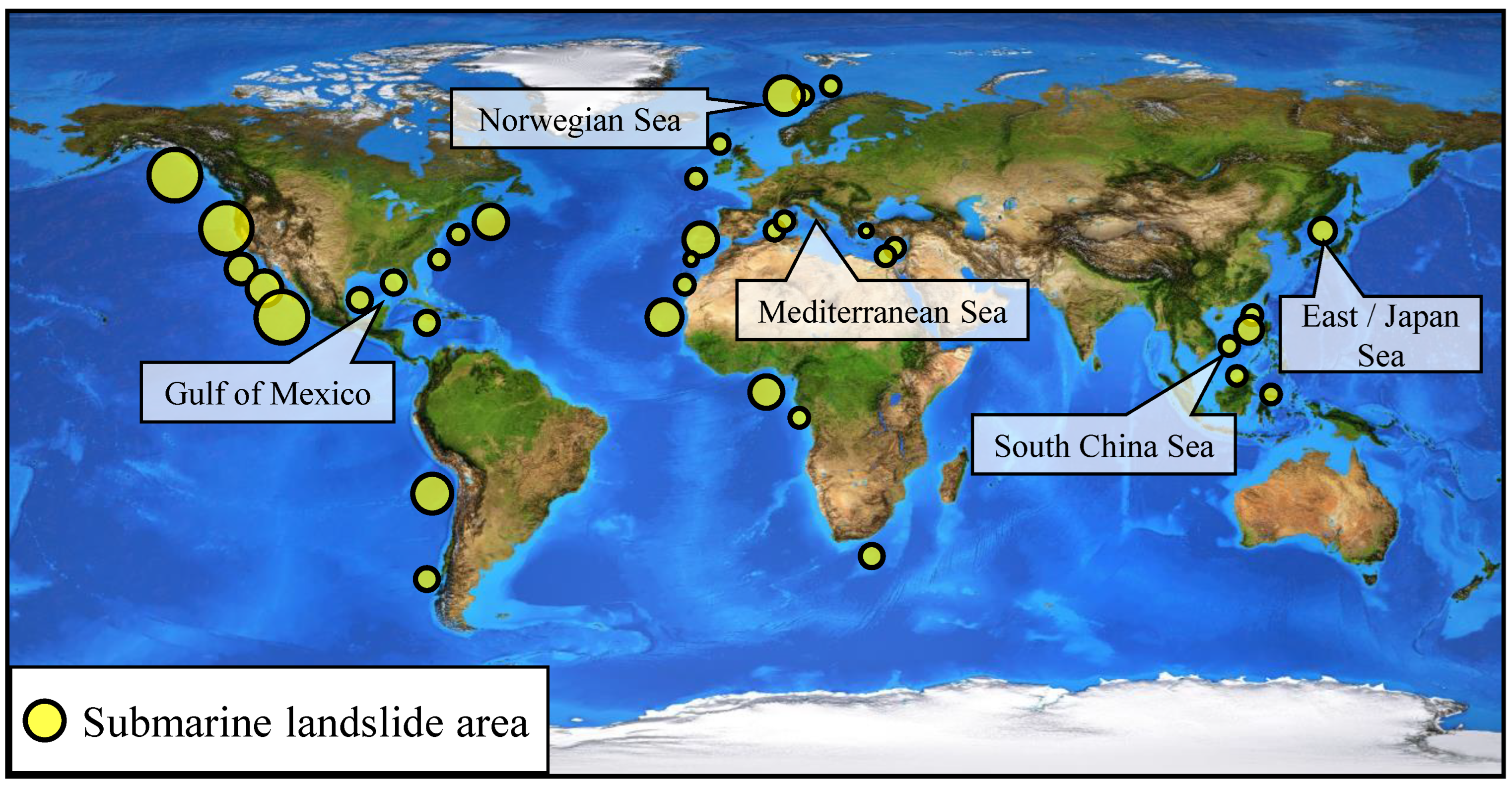
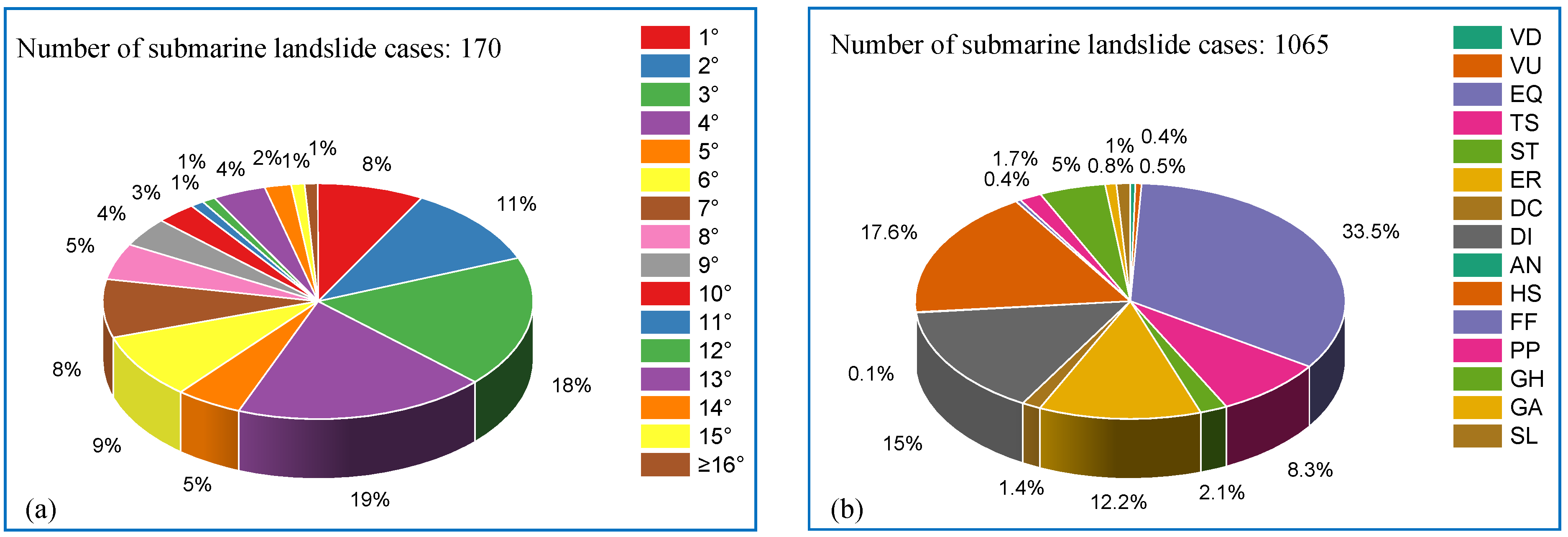
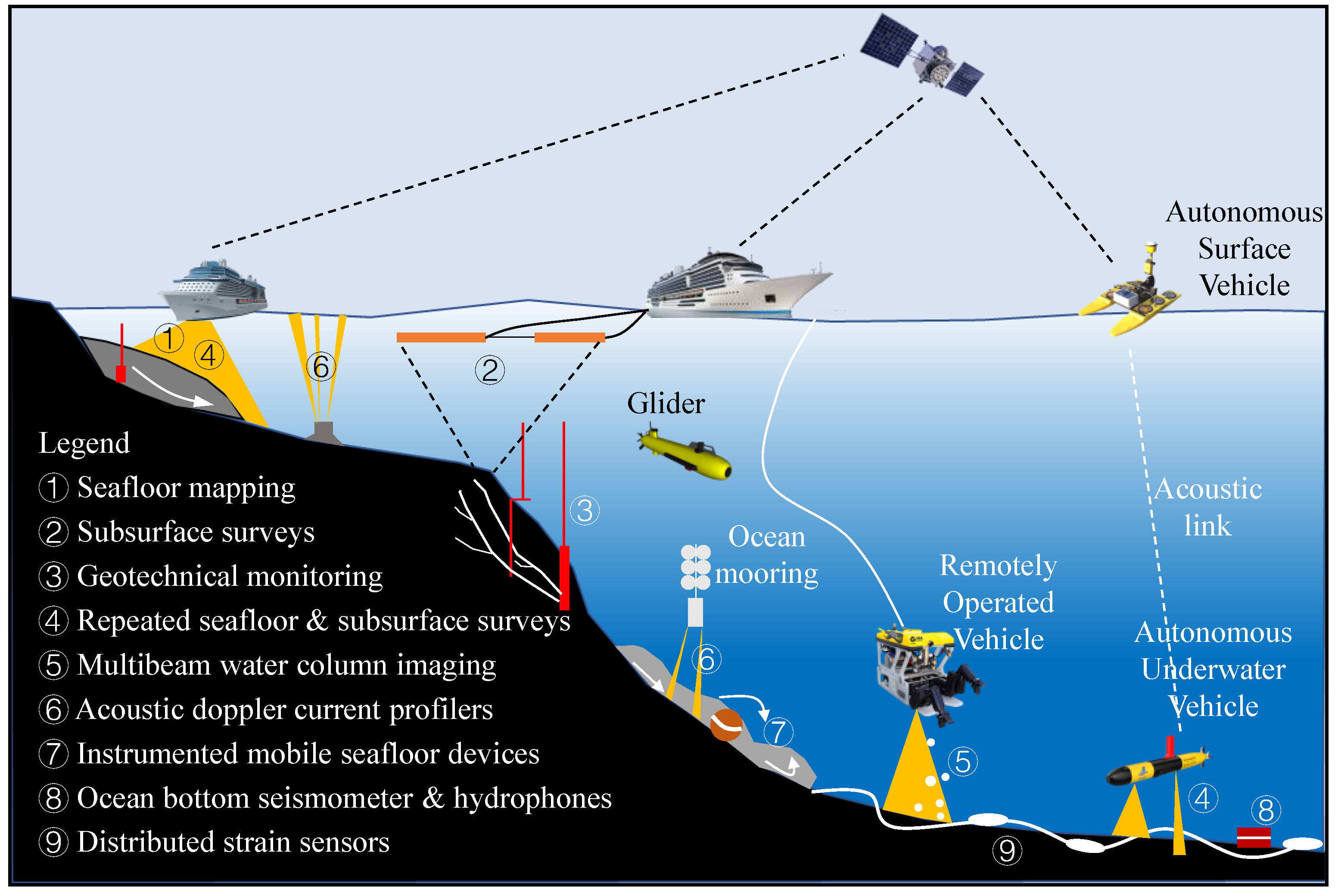

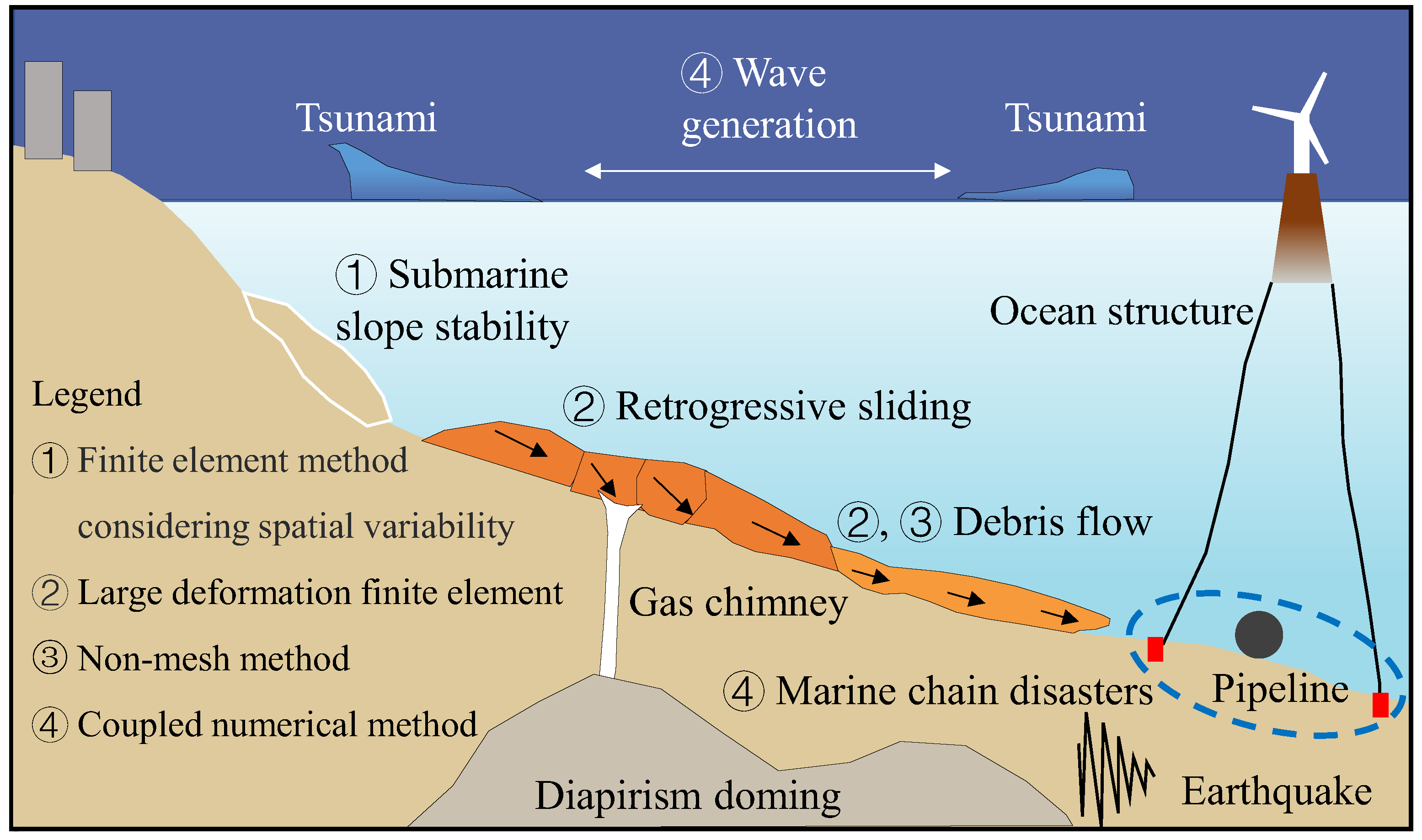
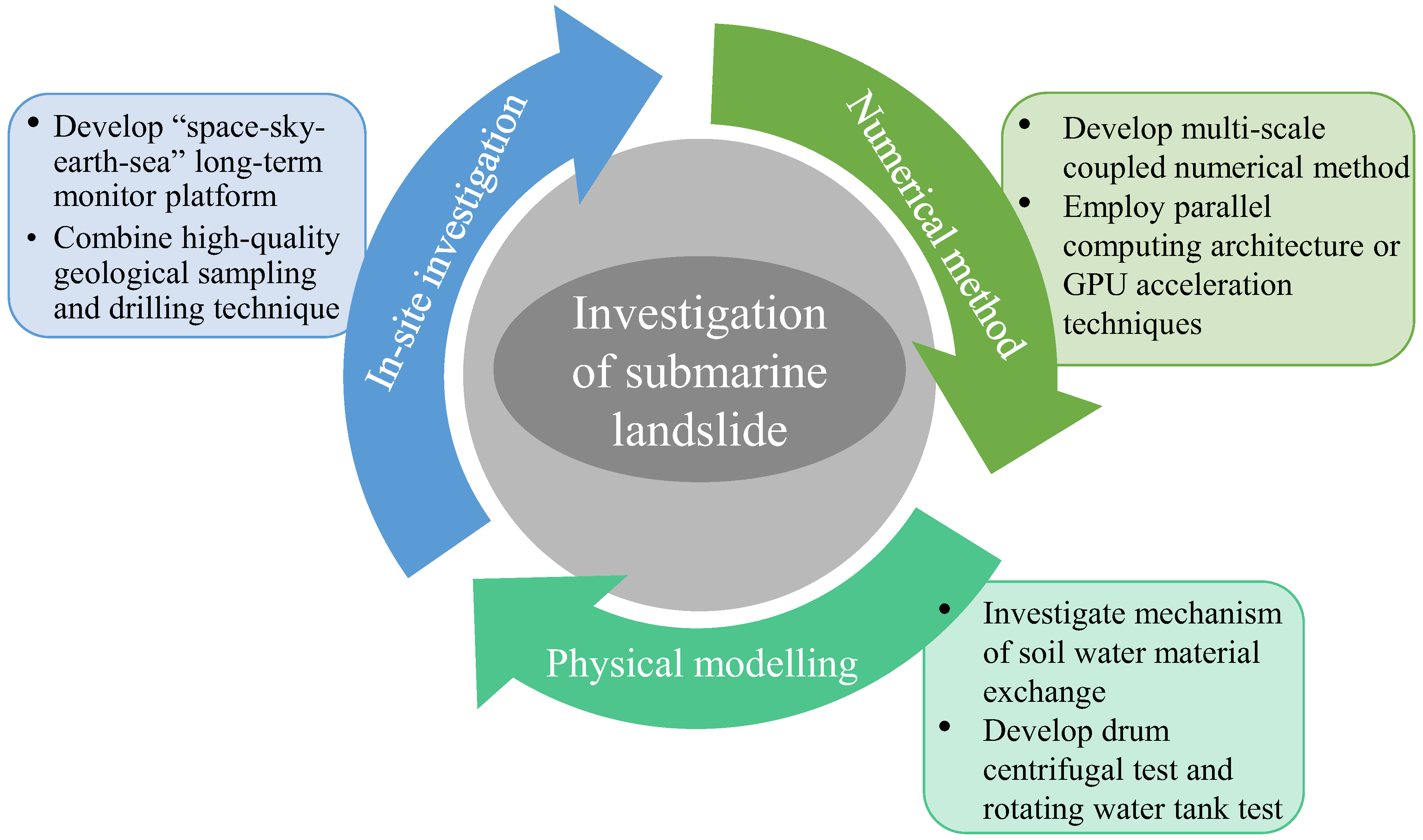
| References | Research Content | Key Conclusions | Highlights of the Review |
|---|---|---|---|
| Locat and Lee [7] | Summarized the causes, classification, characterization, geotechnical investigation methods, and mechanics of submarine landslides. | A major challenge is the integration of submarine landslide movement mechanics in an appropriate evaluation of the hazard. | A comprehensive review of submarine landslides. |
| Harbitz et al. [8] | Analyzed the mechanisms of tsunami generation by submarine landslides. | Submarine landslide volume, initial acceleration, maximum velocity, and possible retrogressive behavior are important to the characteristics of the resulting tsunami. | The focus is on tsunamis induced by submarine landslides. |
| De Mol et al. [9] | Analyzed the relation between cold-water coral bank development and submarine landslides. | No general and direct relationship exists between submarine landslides and cold-water coral banks | This paper focuses on the trigger factors of submarine landslides. |
| Zhu et al. [10] | Summarized the classification of submarine landslide types | The classifications of submarine landslides are becoming more and more deep, detailed, and generalized. | This paper focuses on the classification of submarine landslide types. |
| Yavari-Ramshe and Ataie-Ashtiani [11] | Reviewed numerical studies on submarine landslide-generated waves. | The conceptual, mathematical, and numerical structures of submarine landslide-generated waves are comprehensive analyses. | The focus is on the numerical methods for simulation the tsunamis induced by submarine landslides. |
| Jia et al. [12] | Reviewed the in-situ observation methods of submarine landslides. | The research on in-situ testing method of submarine landslide is still in its early stage and needs to be further studied. | This paper focuses on field investigation and in-situ observation methods for submarine landslides. |
| Huhn et al. [13] | Reviewed triggering mechanisms, monitoring methods, and hazards and risks of submarine landslides. | In-depth study of submarine landslides requires more interdisciplinary approaches. | This paper’s emphasis is on the emerging needs in future landslide research. |
| Nian et al. [14] | Reviewed the advances in the chain disasters of submarine landslides. | The physical and numerical simulation techniques of submarine landslide movement evolution still need further study. | This paper focuses on the simulation methods of chain disasters of submarine landslides. |
Publisher’s Note: MDPI stays neutral with regard to jurisdictional claims in published maps and institutional affiliations. |
© 2022 by the authors. Licensee MDPI, Basel, Switzerland. This article is an open access article distributed under the terms and conditions of the Creative Commons Attribution (CC BY) license (https://creativecommons.org/licenses/by/4.0/).
Share and Cite
Shan, Z.; Wu, H.; Ni, W.; Sun, M.; Wang, K.; Zhao, L.; Lou, Y.; Liu, A.; Xie, W.; Zheng, X.; et al. Recent Technological and Methodological Advances for the Investigation of Submarine Landslides. J. Mar. Sci. Eng. 2022, 10, 1728. https://doi.org/10.3390/jmse10111728
Shan Z, Wu H, Ni W, Sun M, Wang K, Zhao L, Lou Y, Liu A, Xie W, Zheng X, et al. Recent Technological and Methodological Advances for the Investigation of Submarine Landslides. Journal of Marine Science and Engineering. 2022; 10(11):1728. https://doi.org/10.3390/jmse10111728
Chicago/Turabian StyleShan, Zhigang, Hao Wu, Weida Ni, Miaojun Sun, Kuanjun Wang, Liuyuan Zhao, Yihuai Lou, An Liu, Wei Xie, Xing Zheng, and et al. 2022. "Recent Technological and Methodological Advances for the Investigation of Submarine Landslides" Journal of Marine Science and Engineering 10, no. 11: 1728. https://doi.org/10.3390/jmse10111728
APA StyleShan, Z., Wu, H., Ni, W., Sun, M., Wang, K., Zhao, L., Lou, Y., Liu, A., Xie, W., Zheng, X., & Guo, X. (2022). Recent Technological and Methodological Advances for the Investigation of Submarine Landslides. Journal of Marine Science and Engineering, 10(11), 1728. https://doi.org/10.3390/jmse10111728







